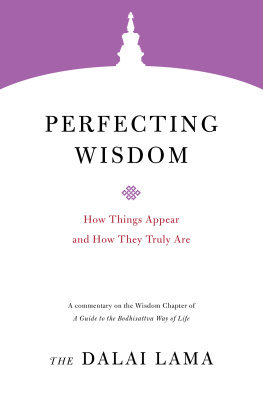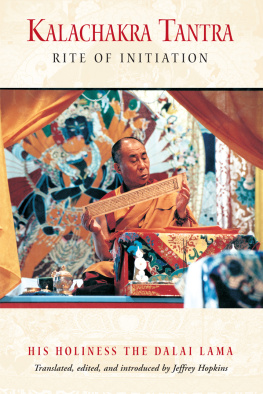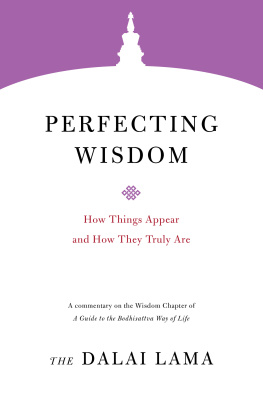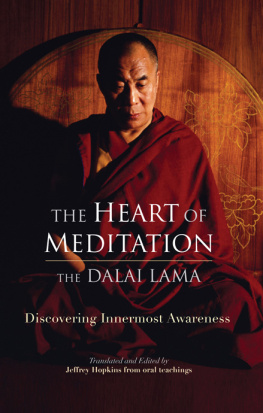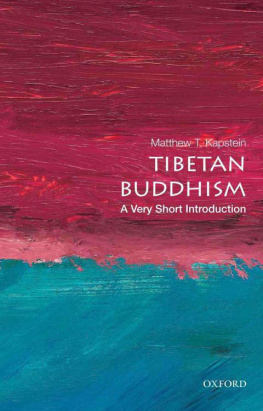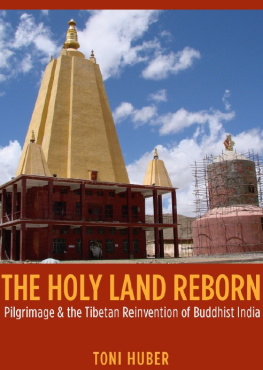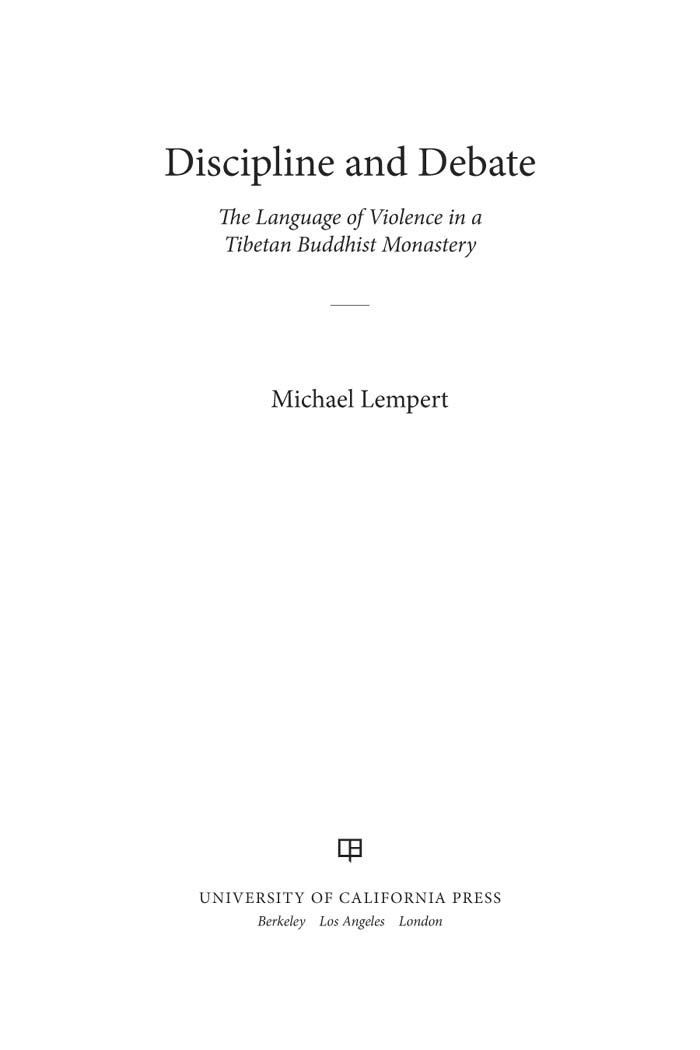Discipline and Debate
Discipline and Debate
The Language of Violence in a Tibetan Buddhist Monastery
Michael Lempert

University of California Press, one of the most distinguished university presses in the United States, enriches lives around the world by advancing scholarship in the humanities, social sciences, and natural sciences. Its activities are supported by the UC Press Foundation and by philanthropic contributions from individuals and institutions. For more information, visit www.ucpress.edu.
University of California Press
Berkeley and Los Angeles, California
University of California Press, Ltd.
London, England
2012 by The Regents of the University of California
Library of Congress Cataloging-in-Publication Data
Lempert, Michael.
Discipline and debate : the language of violence in a Tibetan Buddhist monastery / Michael Lempert.
p. cm.
Includes bibliographical references and index.
ISBN 978-0-520-26946-0 (cloth, alk. paper)
ISBN 978-0-520-26947-7 (pbk., alk. paper)
Buddhist monasticism and religious ordersEducationIndia.
2. Buddhist monasticism and religious ordersEducationChina Tibet Autonomous Region. 3. Liberalism (ReligionIndia. 4. ViolenceReligious aspectsBuddhism. 5. DisciplineReligious aspectsBuddhism. 6. TibetansIndiaReligion. I. Title.
BQ7758.I4L46 2012
294.35697dc22 2011027449
Manufactured in the United States of America
20 19 18 17 16 15 14 13 12
10 9 8 7 6 5 4 3 2 1
In keeping with its commitment to support environmentally responsible and sustainable printing practices, UC Press has printed this book on 50# Enterprise, a 30% post consumer waste, recycled, de- inked fiber and processed chlorine free. It is acid-free, and meets all ansi/niso (z 39.48) requirements.
For my grandparents
CONTENTS
ILLUSTRATIONS
MAP
FIGURES
TABLES
ACKNOWLEDGMENTS
I dont recall how the routine started, but its central prop consisted of a small cylindrical object, usually a AA battery, though a pencil or pen plucked from a nearby table would do. One of my monk friends from South Indias Sera Monasterymy primary field sitewould press the object toward my face, as if it were a microphone; mine was battery driven and had to be monitored constantly, which made AA batteries the perfect metonym for fieldwork stress. He would then rattle off questions about utterly quotidian aspects of my life ( Had I eaten dal and rice today? Was it true that I regularly wore sandals?) but in a hushed, grave, reverential tone, at which point wed all break down in laughter. I earned the sobriquet Interview (dri ba dris lan) for having done one too many. The questions I posed often struck my interlocutors as odd, or obvious to the point of being inconsequential, and everyone thought it strange that I should wish to interview young monkskids, really rather than speak exclusively with the well-socialized and the learned. The monks playful, table-turning mimicry reminds me of a real debt. My interlocutors were busy people. Most were in the throes of demanding classwork in Buddhist philosophical doctrine. Many had left everything and traveled to Sera at great personal risk, enduring the harrowing trek from Tibet into Nepal, just for a chance at a better future. I thank all of my Tibetan interlocutors for finding time to let me learn from them, and for doing so with a degree of patience, warmth, and humor that I still find remarkable.
I am grateful for support from a Fulbright-Hays fellowship, which funded the dissertation research on which this book is based. The University of Pennsylvanias Anthropology Department gave me funds to conduct valuable pre-dissertation fieldwork, and I wrote up my dissertation with the aid of a Charlotte W. Newcombe fellowship and a fellowship from the University of Pennsylvanias School of Arts and Sciences. During my early years of graduate training, I benefited from several years of Foriegn Language and Area Studies funding for the study of Tibetan. I thank the University of Michigan Office of the Vice President for Research for contributing a publication subvention.
The arc of my graduate studies ended up being longer than I anticipated. As my work evolved from the study of Buddhist philosophical texts to that of discursive interaction, I accumulated much intellectual debt, more than I can credit here. At the University of Pennsylvania, where I completed my degree in linguistic and sociocultural anthropology, I thank especially my dissertation committee members: Greg Urban, Stanton Wortham, and, above all, my adviser, Asif Agha, who added far more rigor and conceptual clarity to this project than it would otherwise have had. From my first days of graduate training in linguistic anthropology at Penn, I, like my peers, also felt the avuncular influence of Michael Silverstein, whose scholarship has inspired so many beyond his base at the University of Chicago. Farther back but no less influential were a couple of critical years of doctoral work at the University of Virginias History of Religions program under David Germano and Jeffrey Hopkins. A self-styled apostate, I thought that in leaving religious studies for the social sciences I would end up in a different place. I now see that I have not strayed nearly as far as I imagined. I am still preoccupied with questions that arose in a paper I once labored over for a seminar with Jeffrey Hopkins during my first semester in graduate school. I still find myself puzzling over old issues about Buddhism and modernity, issues that are only half mine, which suggests how glacial intellectual preoccupations can be, and makes me appreciate what made incarceration such an alluring trope in the title of Donald Lopezs Prisoners of Shangri-La: Tibetan Buddhism and the West. Farther back still there is Hubert Decleer, a maverick scholar who introduced me to things Tibetan through the School for International Trainings Tibetan Studies program and confirmed forever my instincts about the virtue of disciplinary irreverence.
I thank my former colleagues in Georgetowns Linguistics Department, especially Deborah Tannen, and present colleagues in the University of Michigans Department of Anthropology. I am grateful to Francis Zimmermann and Michel de Fornel for the invitation to discuss this and other work at Lcole des Hautes tudes en Sciences Sociales in Paris in 2010. For comments on two chapters, I am indebted to a characteristically spirited Michicagoan faculty seminar in linguistic anthropology held in January 2011 (Richard Bauman, Susan Gal, Matthew Hull, Judith Irvine, Webb Keane, Alaina Lemon, John Lucy, Bruce Mannheim, Barbra Meek, Constantine Nakassis, Stephen Scott, Michael Silverstein, Robin Queen, and Kristina Wirtz). Several colleagues graciously read portions of the manuscript of this book: Sepideh Bajracharya, Anya Bernstein, Luke Fleming, Niklas Hultin, Judith Irvine, Webb Keane, Matthew Hull, Donald Lopez, Sabina Perrino, and Joel Robbins. A number of others fielded questions and offered advice, including Robert Barnett, Jos Cabezn, Geoff Childs, Melvyn Goldstein, Zeynep Grsel, Sherap Gyatso, Lauran Hartley, Toni Huber, Charlene Makley, Amy Mountcastle, Erik Mueggler, Stephanie Roemer, Gray Tuttle, and Nicole Willock.
Several graduate research assistants provided help. Jermay Reynolds of Georgetown Universitys Linguistics Department assisted with aspects of the textual analysis in chapter 3, and Patrick Callier of the same department did prosodic work for me on chapter 4. In 2011, Charles Zuckerman of University of Michigans Department of Anthropology provided technical, font-related help, and Jessica Krcmarik (University of Michigan, Class of 2012) did artist renderings of digital photos. I received fresh inspiration to finish this book in 200910 thanks to a yearlong interdisciplinary faculty seminar at the University of Michigan convened by Tomoko Masuzawa and Paul Christopher Johnson and entitled Initiative on Religion and the Secular.


